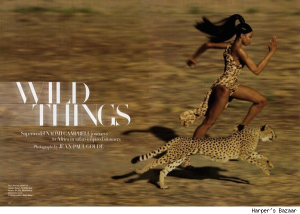
on comparing women with animals
Fox, cow, bitch, vixen, cougar, whale, chick. What do these terms have in common? They refer to animals. Anything else? They also refer to women.
As someone who learned to speak English as a second language and was not surrounded by these colloquialisms at an early age, I remember being puzzled when I first heard a woman called a “cougar” or “fox.” I remember finding the terms “cow” and “whale” particularly jarring and harsh, though the person who uttered them didn’t give it a second thought.
Admittedly, all human beings are sometimes associated with animals. Someone who eats quickly “wolfs down” their food, someone who is bossy “barks orders,” and someone who is dangerous is “animal.” (Not to mention the animal metaphors referring to sex or the organs associated with it; those are too numerous and complicated to discuss here.) But animal comparisons usually comment on negative behaviors and characteristics, so they become problematic when they are not applicable to everyone, but only to specific groups.
Such is the case with the many animal metaphors that society has invented to refer specifically to women—usually those who do not look or act the way an ideal woman “should.” For example, a cougar is a woman who is dating a younger man, which often puts her in a position of power in the relationship. This does not necessarily fit into society’s expectation of where a woman belongs, so these relationships are often treated with unease or as a joke. Note that there is no equivalent term for a man who is dating a younger woman because men who do so are not trivialized, but celebrated. (Among many examples is Hugh Hefner, whose franchise relies on this double standard.)
There are also “catty” women who are considered petty, malicious, and aggressive, though also somewhat entertaining. Society enjoys pitting women against each other for the amusement of others (see: the majority of reality television) while also trivializing our anger. This is exemplified in the notion of the “bitch,” a word which nearly every single woman has heard aimed in her direction at least once, perhaps because one must only show the slightest expression of passion, anger, or discontent in order to be considered bitchy. As soon as she becomes indignant and raises her voice, a woman loses credibility because she’s considered annoying, whiny, high maintenance, or “nagging” (a nag is an old, tired horse). Women in recent years have taken to reclaiming the term, of course, but the fact remains that the swiftest way for someone of any gender to undermine a woman is to call her a bitch.
The funny thing is that even though outspoken women are usually given this name, the term is also applied to men in the opposite situation: when they are showing weakness, submissiveness, or fear. And so a “bitch” is a woman who acts too much like a stereotypical man or a man who acts too much like a stereotypical woman. In fact, there are few animal metaphors that refer exclusively to men, and the majority of those that do are meant to emphasize strength and sexual prowess. These include the comparisons to stallions, wolves, and dogs… none of which I hear too often, but none of which belittle, demean, or sexualize men either.
Unfortunately, women-animal associations are present in our imagery and advertisements as well, and though it would take a whole different blog post (or several) to discuss this trend, it should at least be noted that the animal metaphors do not stop with language. Just look at playboy bunnies or PETA protests that feature women in cages. But it’s especially prevalent in ads that feature women of color, often showcasing them with an animal, painted as an animal, and/or posing as an animal. Such ads draw on our society’s historical tendency to depict people of color—and in fact, many oppressed groups—as primitive, wild, inferior, and needing to be controlled. And as demonstrated through advertising, they continue in today’s public consciousness as stereotypes.
Ultimately, animal metaphors not only serve to judge and punish those who deviate from societal norms, but ensure that it does not happen again. In the case of women, this is because no one wants to be considered catty, or a bitch, or a cow. In those moments, a woman is reduced to one trait: her size, tone, age, or appearance. Her intelligence, complexity, or even humanity is no longer considered relevant.
Originally posted on SPARK’s blog

